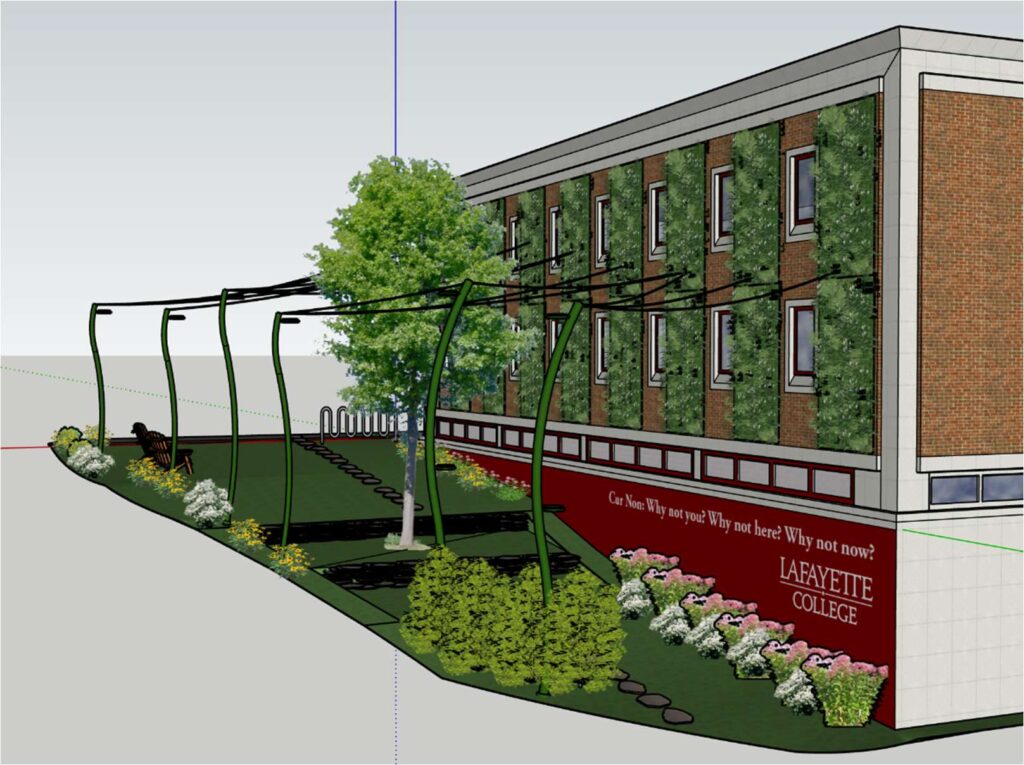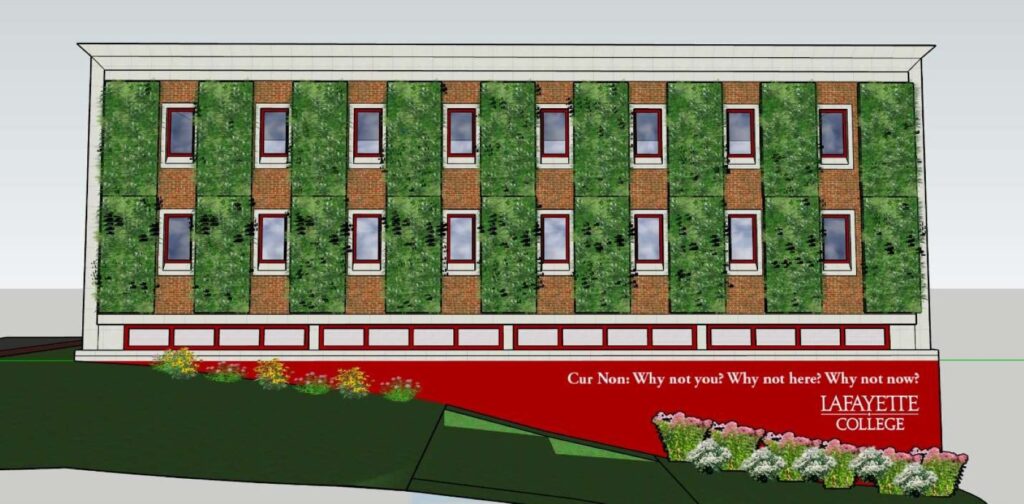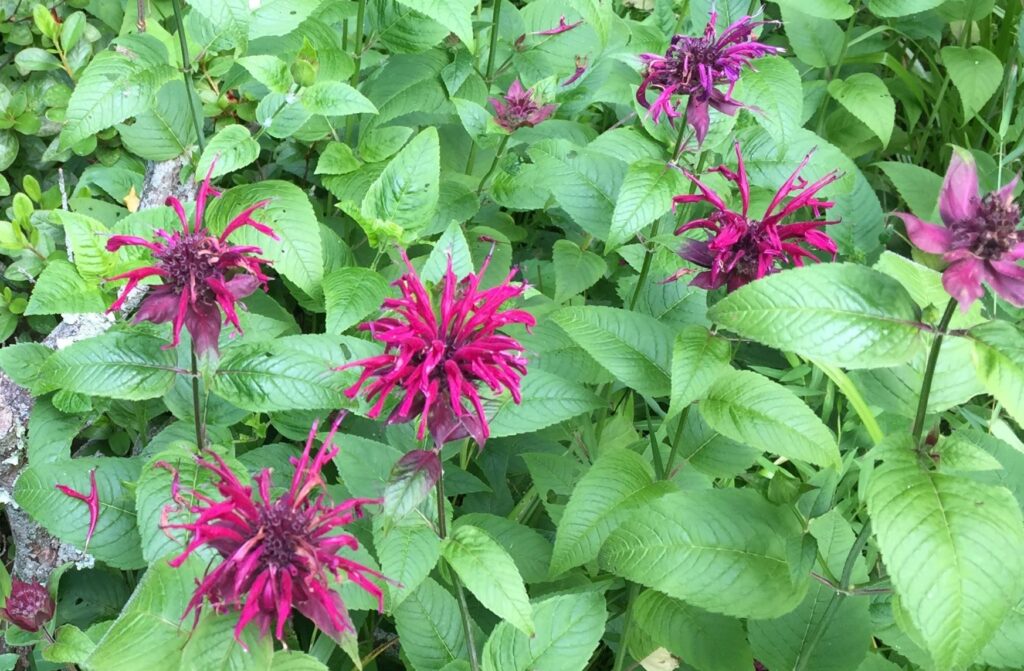Greening Lafayette
By Bryan Hay
Visitors, students, staff, and faculty who enter campus from the west side of Markle Hall parking deck have worn a narrow dirt path as a shortcut up a slope, passing, likely without much notice, an unremarkable exterior brick wall at Acopian Engineering Center.
But one day that routine walk may be dramatically slowed down and transformed into a calming respite from classes, deadlines, and assignments.
Students in Prof. Benjamin Cohen’s upper-level, project-based Sustainable Solutions class this spring finalized a comprehensive proposal to build a living wall and an adjacent communal garden space on the northeast side of Acopian. Alive with native plants, Lafayette Gardens would create an oasis designed to facilitate education, recreation, and place-making opportunities on campus.

A view of Lafayette Gardens from Markle parking deck
A culmination of three years of ideas and work developed in independent studies and by students in previous engineering studies capstone courses, the project took root this year. Although financial challenges and obstacles caused by the pandemic will understandably push back the proposal’s next steps, Cohen and his students have an incredibly detailed plan— nearly 100 pages in length— that’s ready to execute when the time is right to move forward with Lafayette Gardens.
The report describes a living wall that would grow on a system of small containers attached to a façade on the brick exterior of the northeast side of Acopian in a vertical column pattern. With biodiversity, habitat, growing cycles, and ease of maintenance in mind, students selected plants native to Pennsylvania–spicebush, spring-beauty, forest goldenrod, violet, common blue, Rosa Virginiana, wild bergamot, inkberry, three-lobed coneflower, cutleaf coneflower, and Joe-Pye.
Underneath it, where there is currently a bare concrete triangle, students proposed adding a mural to display Lafayette College’s motto: “Cur Non? Why not you? Why not here? Why not now?”
Surrounding ground space, a .08-acre area that extends toward Markle Hall, would contain sets of 6-foot-diameter pollinator gardens as well as teaching and gathering areas. Seating options for Lafayette Gardens would include Adirondack chairs and terrace seating, the latter of which would require modifications to the existing slope.
The edge of the grass would be lined with six thin, curved spires that connect back to the living wall via wires. Spires and wires are intended to help create a sense of calm enclosure and add three-dimensional definition to the space.

“Engineering studies and art have had a long and collaborative relationship. So I had conversations a handful of years ago with Jim Toia (director of the art department’s community-based teaching program) and Ed Kerns (Eugene H. Clapp II ’36 Professor of Art) about space and aesthetics,” says Cohen, associate professor of engineering studies. “I had worked in Acopian enough at that point to know that it was a little too institutional, a little too hospital-like. Students frequently talk about it that way.”
Through a mashup of various conversations, a group of students in the engineering studies capstone three years ago considered ways to add a more artistic façade at Acopian that would help encourage a better sense of placemaking and comfort, “to make the place feel good,” Cohen says.
An early version looked to the rear glass-enclosed staircase at Acopian, which appealed to Cohen because of its visibility in the distance. The next year, an independent study shifted the garden to the side of the building, which has more exposure to sunlight for nurturing plants and other environmental features.
Fertile ground for further creativity and exploration, it all offered a solid starting point for Cohen’s students this year. “They began with past proposals and really ran with it,” he says.

Wild bergamot, one of the native plants selected for the living wall
Five students and Cohen, who served as project manager, formed a cohesive team that coalesced over the 14-week spring semester into more of a consulting firm as opposed to a lecture or seminar college class.
Each student assumed a specific area of responsibility:
Nika Cinicola ’20, communications director, organized meetings, built community contacts, led efforts on presentations, and spearheaded authorship of the final report and Greening Acopian website.
Bryce Currie ’20 acted as chief economist and worked on determining cost and assessing the various values of Lafayette Gardens.
Diana De La Torre ’20 served as environmental and sustainability engineer and worked with nurseries, landscapers, and LaFarm’s Lisa Miskelly to select native plants to increase biodiversity.
Major Jordan ’21 took on the role of structural engineer, responsible for determining various structural aspects for the proposed design.
Lisa Sholtz ’21 was the team’s artistic design director and developed visual components of the project, including the final design plan for Lafayette Gardens.
“These five students did an incredible amount of work,” says Cohen, noting that the shift to remote classes, while potentially resulting in a demoralizing situation, did not diminish the group’s enthusiasm and work ethic.
“There was congeniality, never any arguments, no ego or concern. They just all did the work,” he says. “We worked collectively to build the syllabus as we went, always working to build our resource base and add in new areas of background. Honestly, I looked forward to it each week. We were more like a consulting group, as if we had been hired. Everyone rose to that challenge.”
Their work has the potential to develop a deep root system across campus.
Lafayette Gardens would not only add organic luster to a bland wall, it would also complement the College’s Climate Action Plan and ongoing renovations at Acopian, Cohen notes. The class had informal input from a range of campus voices, including Scott Hummel, William Jeffers Director of the Engineering Division; Joe Biondo, instructor of architecture; Mary Wilford-Hunt, senior associate director of corporate, foundation, and government relations; Jim Toia, director of the community-based teaching program; and Kendall Roberson from the Office of Sustainability. They also gave informal presentations to an additional cohort of students and faculty, who served as mini focus groups during the design process, and consulted with environmental professionals on issues of biodiversity, energy savings, and maintenance.
Additionally, the Gardens would offer a memorable addition to admissions tours, the proposal points out. Prospective students and their families would have a straight view of Lafayette Gardens from Markle parking deck, and when tours exit Markle Hall, the first thing visitors would see when they look to the right is the Lafayette Gardens area.
For Cohen, Lafayette Gardens marks his third Sustainable Solutions project that has led to tangible outcomes. Along with Lafayette Gardens, others are the climate change vulnerability assessment for the city of Easton and the Musical Path at Karl Stirner Arts Trail.
Asked where Lafayette Gardens ranks among those and other student-led projects, Cohen didn’t hesitate.
“It’s at the top.”